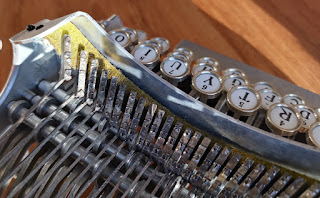On Wednesday, December 16th of 1931 this typewriter was purchased in England, most likely bought in London. It was purchased by a Dutch secretary working at the head-office of the Unilever company, then an Anglo-Dutch concern. She was probably travelling frequently between the Rotterdam and London head-offices. The date of purchase was written on the Remington "World Service" label stuck inside the lid of the carrying case.
The typewriter is a then-current Remington Portable 3 in gloss-black. It has a British keyboard layout, so it sports the now-popular @-character and an ample supply of fractions. It is a sober-looking, serious portable typewriter of a quality make.
This typewriter was used a lot and with care, always kept in its case. When it was handed down to her descendants, it was put away safely and stored in a dry and warm location. Many decades later in the 21st century, it was sold to me by her son. He was anxious that it should not end up being scrapped or abused (or 'up-cycled'), but appreciated and preserved. We have tried to do just that.
It only required light cleaning, the typewriter was free of rust and the paint-loss is appropriate for a machine being used well. The platen was however rock-hard; this was sent off to a professional re-surfacing service and now has a fresh covering of 'Contirite' rubber. A few screws needed tightening (carriage-lock bracket has almost worked itself loose), and the shift-position could perhaps be aligned better. The overall condition of the machine so far stopped me from taking-off the housing to adjust the shift; it is simply too nice to risk removing the housing and it types really well as it is.
Its parts were made in America, yet it was assembled in Britain. This means the typewriter has a label that it's made in the USA (on the front), and a text on the back-panel with the extra information that it was assembled in London.
The 240,000 number would place it in November 1929 for the US production. It is possible that this machine remained unsold for 2 years, but also possible that serial-numbers of British machines lag the US numbers.
It is very probable that blocks of numbers were assigned from the US to the London factory who could then manufacture from this block. Unlikely to telegraph new serials every month, more probable that a batch of numbers was periodically assigned for the parts-shipment to London. E.g. twice a year.
The London-prefix numbers were either stamped in London at the machine's assembly, or already complete with prefix during parts-manufacture in the US: marked as a 'housing for shipping out'. It is possible that the production-rate in London meant that the 240,000 number was reached in the British factory only in 1931 - in a numbers block (and parts-shipment) assigned to London at the end of '29.
An expensive item like a typewriter would be unlikely to spend more than a few weeks from being manufactured to being in a shop. A shop would however depend highly on chance, and may have had a machine in the shop for a year.
It's probably the combination of both, spending time in a store and lagging of London assembly, perhaps by December 1931 the shop really wanted to sell it and gave a discount :)
Whichever way, a November 1929 or a mid 1931 machine; it is a fine, typical specimen of the third iteration of the Remington portable typewriter.
A regular, black Remington Portable 3 typewriter - a quality typewriter from around 1930.





















































































































































